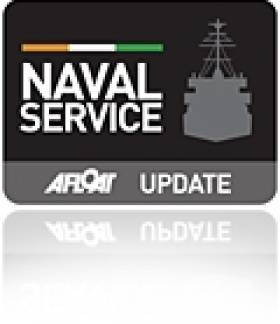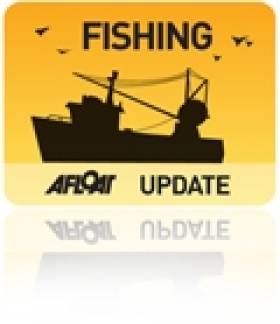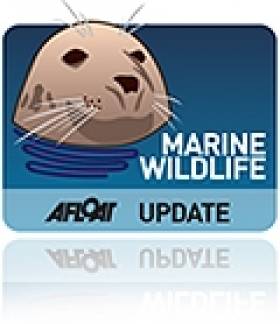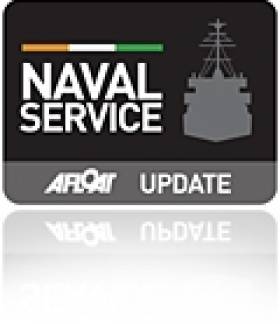Displaying items by tag: LE Niamh
Naval Vessel L.É. Niamh Departs Cork to Assist in the Humanitarian Crisis in the Mediterranean
#navy – L.É. Niamh under the command of her captain, Lieutenant Commander Daniel Wall departs the Naval Base, Haulbowline this evening, en route for the Mediterranean to assist the Italian authorities in the humanitarian operation to rescue migrants fleeing North Africa.
The Minister for Defence, Mr. Simon Coveney, T.D., had announced earlier this month that L.É. Niamh would deploy to the Mediterranean to continue Ireland's contribution to the search and rescue mission. L.É. Eithne has spent the past eight weeks in the Mediterranean and has set out on her return to Irish shores. A total of 3,377 people have been rescued by L.É. Eithne from the waters between Libya and Sicily.
Defence Minister Simon Coveney said "I had the opportunity of visiting L.É. Eithne last Tuesday. I conveyed to the personnel our deep appreciation for the outstanding manner in which they performed their duties on overseas service on behalf of the Government and the people of Ireland. I am pleased to be here today to convey my appreciation to you, in advance of your deployment."
L.É. Niamh with a crew of 55 Naval Service personnel and 2 medics from the Army Medical Corps will continue the remarkable work started by L.É. Eithne. The Minister went on to say "L.É. Niamh is expected to be deployed in the Mediterranean until September, dependent on the operational demands and requirements arising."
The Minister concluded by saying "I want to wish Lieutenant Commander Daniel Wall and the crew of L.É. Niamh a safe and successful mission. You are travelling to the Mediterranean with my best wishes and with those of the rest of the nation."
Navy Ship LE Niamh Operating In Stormy Seas off the Irish Coast
#navy – A view from the bridge of LE Niamh, shows just how rough conditions can be around our coast for the Irish Navy on patrol. But, as this Defence Forces footage reveals, the 78m vessel is designed for just such winter North Atlantic operations.
The ship, the youngest in the Irish fleet, was designed by STX Canada Marine (formerly Kvaerner Masa Marine) and has an all-steel hull based on the Mauritian Vigilant patrol vessel launched in 1995, but without the helicopter deck and hangar facilities.
The high level of automation incorporated into the ship's systems allows the ship to be operated with just 44 crew including six officers.
Navy Detain Irish Trawler off Ballycotton
#NAVAL SERVICE –An Irish registered trawler was detained by the Naval Service OPV L.É. Niamh (P52) some 50 nautical miles south of Ballycotton, Co. Cork in the early hours of yesterday morning.
The detention was in relation to alleged breaches of technical fishing regulations. The trawler was taken under escort by the OPV to Cork and was to be handed over to the Gardaí.
So far the Naval Service in 2012 have carried out 1006 boardings, issued 38 warnings and detained 13 vessels.
Royal Navy Attend Presidential Fleet Review for Cobh Titanic 100
#COBH TITANIC 100 - Following President Michael D. Higgins visit to Cobh to commemorate the centenary call of RMS Titanic to Queenstown, the town yesterday hosted a Naval Service review that included the Royal Navy's HMS Mersey.
The President as supreme commander of the Defence Forces boarded the Naval Service 'flagship' L.E. Eithne which passed the guest-ship, a River class patrol vessel which headed a line of vessels which lay at anchor of Cobh's waterfront, they were the L.E. Aoife, L.E. Aisling and L.E. Niamh
The historic event which marked the pinnacle of the Titanic 100 Cobh centenary week will continue as part of a year-round programme of events. For information visit www.titanic100.ie. On the homepage the L.E. Niamh features again, where on this occasion marine photographer Jehan Ashmore captured the vessel underway as she powered her way at high-speed through a misty Dalkey Sound.
Among the many places throughout Cobh where thousands of tourists have flocked since the Balmoral docked on Monday to retrace the liner's maiden voyage, has been the White Star Line pier.
From this pier were the last passengers to depart Queenstown on board the tenders PS Ireland and PS America to the ill-fated Titanic that struck an ice-berg. On her Irish call 123 passengers were transferred to the Titanic which lay outside Cork Harbour, while 7 passengers disembarked from the liner and headed ashore.
What remains of the pier which is not accessible to the public and is in danger of collapsing, there has been calls to raise funds to save the structure, as previously reported.
Also in attendance during yesterday's historic proceedings, was the excursion passenger tender Spirit if the Isles which is operating on her second season since starting Cork Harbour cruises last year. They run between Cork city quays and downriver along the Lee to Cobh.
In the 1980's the tender then named Ingot ran excursions from Dun Laoghaire Harbour into Dublin Bay and likewise of L.E. Niamh, she too transited Dalkey Sound as part of her sightseeing tours.
- RMS Titanic
- White Star Line
- Cobh Cruise Callers
- Cobh, Cork Harbour
- Cruiseships
- Balmoral
- FredOlsen Cruise Lines
- Titanic Memorial Cruise
- naval service
- LEEithne
- Royal Navy
- HMS Mersey
- President Michael D Higgins
- Queenstown,Ireland
- PS Ireland
- PS America
- Spirit of the Isles
- Cork Harbour Cruises
- Cork Harbour News
- Dalkey Sound
- LE Niamh
- LE Aoife
- LE Aisling
- Cork Harbour
- River Class Patrol vessels
- River Lee
- Irish marine photographers
Fishing Vessel Detained in Cork
The Irish Times reports that the Naval Service detained a Spanish-registered fishing vessel off the Clare coast in the early hours of Tuesday morning.
The vessel was escorted by the LE Niamh to Castletownbere in Co Cork, where it was handed over to gardaí in relation to an alleged breaching of fishing regulations.
No other information is yet known but Afloat.ie will update as details arise.
Increased Naval Presence for Queen’s Visit
The most modern naval vessel of the eight-strong fleet the LÉ Niamh (P52) is an offshore patrol vessel (OPV) which is equipped with a bow-mounted 76mm gun. To see the crew undertake exercise-drills of the gun, watch the video below.
Navy Escort Detained Trawler to Castletownbere
Less then a month ago the Naval Service detained a Northern Irish registered fishing vessel the Lynn Marie seven miles east off Bray Head. Onboard was a crew of 4 UK nationals who were taken into custody to the Gardai after the trawler was escorted by the CPV L.E. Orla to Dun Laoghaire Harbour. To read more about this detention click here.
Ironically the L.E. Orla was a former Royal Naval vessel, HMS Swift (P241) which was deployed on her first assignment to the Hong Kong Patrol Squadron for a four-year period. In 1988 Margaret Thatcher's Conservative Party Government disposed HMS Swift and HMS Swallow (P242) to the Irish Naval Service. The pair were built by Hall Russell Shipyard of Aberdeen as part of an eight 'Peacock' class coastal patrol vessel (CPV).
The 'Peacock' pair were commissioned into the Naval Service and renamed L.E. Orla (P41) and L.E. Ciara (P42) in a ceremony attended by An Taoiseach Charles J. Haughey at the Naval Base in Haulbowline, Cork Harbour.
This weeks' detention is the second conducted by the Naval Service in 2011. Last year the Naval Service carried out 1,666 vessel boardings which resulted in 70 warnings and eight detentions.
- Irish Naval Service
- Cork Harbour
- Northern Ireland
- Haulbowline
- castletownbere
- naval service
- LE Niamh
- Royal Navy
- Ports and Shipping News
- Lynn Marie
- Fishery Breaches
- Fishery Detention
- Fishing Trawler
- Peacock Class
- Hong Kong
- Hall Russell
- Appledore Shipbuilders
- LE Orla
- HMS Swift
- LE Ciara
- HMS Swallow
- Margaret Thatcher
- Conservative Party
- An Taoiseach
- Charles J. Haughey
- Naval Base
Ireland Sees Largest Aggregation of Killer Whales
The Irish Whale and Dolphin Group (IWDG) has announced the largest aggregation of killer whales to date in Irish waters.
As many as a dozen killer whales, or orca, were spotted close to an Irish Naval Service vessel on patrol 30 miles off Tory Island in Co Donegal late last month.
According to Lt Cmdr Paddy Harkin of the LE Niamh, the killer whales were feeding among large shoals of mackerel that also attracted a large number of fishing vessels.
He added that the whales had apparently followed the mackerel from west of the Hebrides in north west Scotland, according to several fishing skippers - who placed their numbers at over 100.
The IWDG has more on the story (including photos) HERE.
The Minister for Defence, Mr. Tony Killeen, TD, with his cabinet colleague the Minister for Finance, Mr. Brian Lenihan, TD, were today, at the Naval Service Base in Haulbowline, Cork to welcome home the Naval Service vessel the L.E. Niamh from her ten week mission to Latin America.
This deployment was in support of the strong cultural and heritage links between Ireland and South America, to mark the celebration of the bicentenaries of independence by Mexico, Argentina, and Chile, and to promote Ireland and Irish trade links in these countries.
The Captain of the LE Niamh is Lieutenant Commander Kenneth Minehane, a native of Bantry, Co. Cork, and there were 46 crew on the mission.
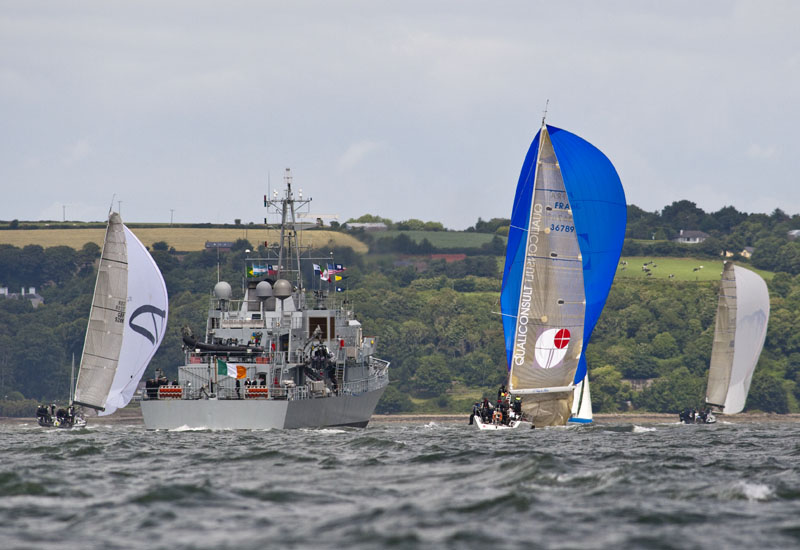
LE Niamh arrives back into Haulbowline today. Photo: Bob Bateman
Speaking on the LE Niamh in Cork Minister Killeen said "The trade and diplomatic mission to Latin America, which was undertaken by the LE Niamh, was a significant initiative from Ireland's perspective and is an example of the continued effective inter-departmental cooperation, particularly in the area of trade. The Captain and crew of the ship have carried out excellent work on behalf of the State in furthering our national interests in the region. I would like to commend them on their achievements and thank them for their service."
Minister Killeen continued "I am delighted to be able to announce today that following discussions with my cabinet colleague Mr. Brian Lenihan, T.D., Government approval has been received for the Department of Defence and the Naval Service to enter into discussions with UK based shipbuilder Babcock Marine, with a view to finalising negotiations for the purchase of two new Naval Service Offshore Patrol Vessels (OPVs).
The decision to proceed with the final award of the contract to purchase the OPV's is subject to these negotiations reaching a satisfactory outcome. I hope to be in a position to make a formal announcement regarding the award of the contract for the new OPV's by November 2010. However, as you can appreciate, as negotiations are ongoing it would be inappropriate for me to comment further on them at this time except to wish the officials in the Department of Defence and the Naval Service well in these negotiations".
Minister Lenihan said "I am also pleased to be here in Haulbowline this afternoon with Minister Killeen for this major announcement. I am especially pleased that in agreeing the Defence Estimates for 2011 it has been possible to provide for this key defence priority."
The older naval ships have a nominal lifespan of 30 years. By 2015, all but two of the current flotilla of eight Naval vessels will be at least 30 years old (which is the normal maximum lifespan of such vessels). The continued use of older vessels is expensive in terms of both maintenance and, more importantly, loss of days on patrol. Notwithstanding increased inspections, maintenance and repair, it is not recommended that any vessel should remain in service beyond 35 years.
The three oldest vessels, LE Emer commissioned in 1978, LE Aoife commissioned in 1979 and LE Aisling commissioned in 1980, remain in service through a programme of continuous planned and preventative maintenance and inspections. These inspections have recently resulted in extensive repairs being carried out to all three vessels with holes in the hull plating of each being detected and repaired in the course of dry docking. All three vessels were out of service for approximately 6 weeks.
Minister Killeen added "The acquisition of two new modern vessels will ensure that the Naval Service continues to be fully equipped to carry out its day to day roles in enforcing the State's sovereign rights over our waters and our fisheries and meeting Ireland's obligations in the area of maritime safety and security and fisheries protection. I am acutely aware of the difficulties for Irish fishermen arising from the damage inflicted by over fishing of some key stocks off our coast. The Naval Service plays a significant role in helping to return these stocks to sustainability."




























